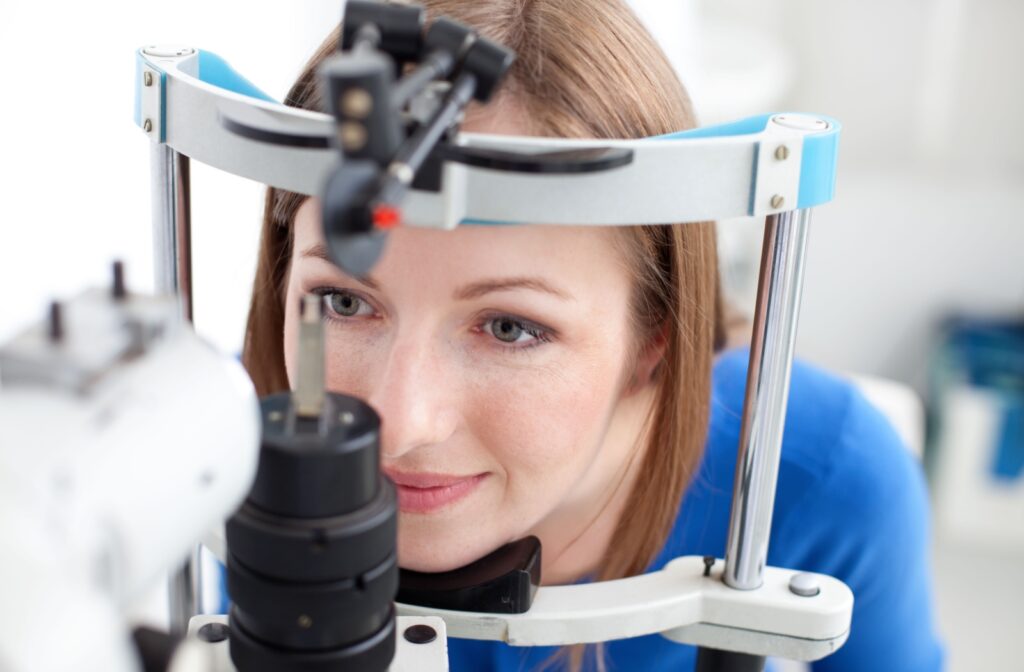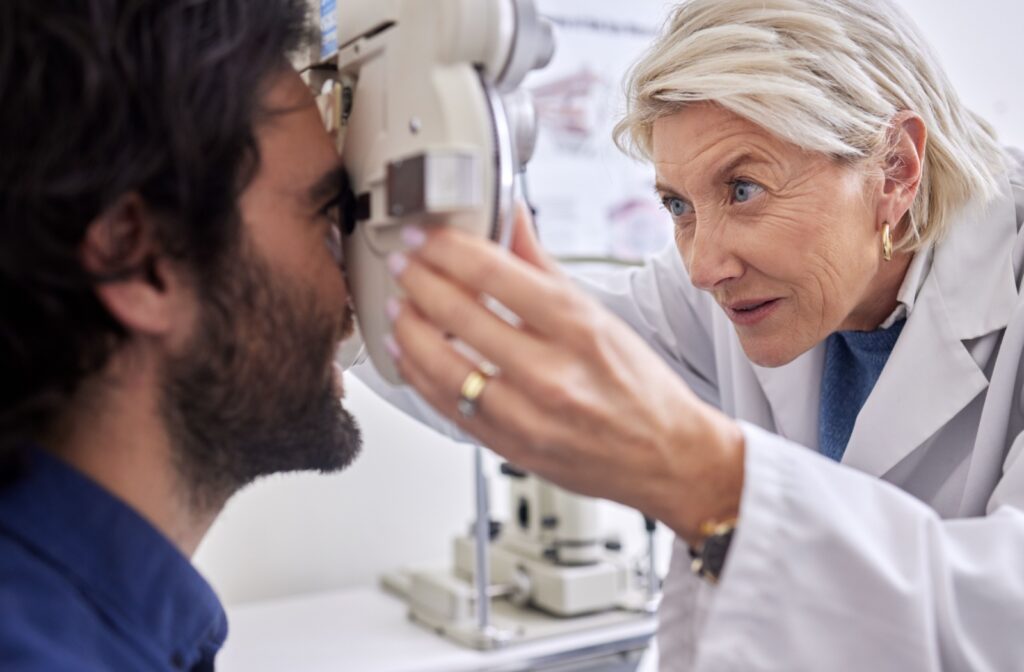A visit to the eye doctor is a key part of your family’s overall health care. Understanding what happens during this visit can help you feel prepared and confident in your care.
A comprehensive eye exam includes a series of tests that evaluate your visual acuity, how your eyes work together, and the physical health of your eyes from the front surface to the back. These tests give your eye doctor a complete picture of your vision and can help detect potential issues early.
Let’s walk through the different parts of a thorough eye exam.
Vision Screening vs. A Comprehensive Eye Exam
It’s helpful to know the difference between a quick vision screening and a full eye exam. While both check your sight, one is much more detailed than the other.
What Is a Vision Screening?
A vision screening is a basic test to see if you have any obvious vision problems. These are often done at schools, health fairs, or the DMV. Screenings can catch certain issues, but they aren’t designed to provide a complete evaluation of your eye health.
What Is a Comprehensive Exam from an Eye Doctor in San Diego?
A comprehensive eye exam is a thorough assessment performed by an optometrist or ophthalmologist. They use a wide range of procedures to get a full picture of your eye health.
Key Parts of a Comprehensive Eye Exam
Your eye doctor performs several tests to check your vision and the physical condition of your eyes. Most exams include the following components:
Your Health & Vision History
The exam starts with a conversation about you. Your eye doctor asks about your personal and family health history and any medications you take. You’ll also discuss any vision problems you may have noticed.
Tests for How Well You See
- Visual Acuity Test—This is the classic eye chart test where you read letters from a distance. It measures how clearly each of your eyes can see.
- Refraction Test—This test helps determine your exact prescription. You’ll look through a device called a phoropter and tell your eye doctor which lenses make the letters look clearest.
Tests for How Your Eyes Work Together
- Eye Movement & Alignment—Your optometrist checks how well your eyes move and work as a team. This simple evaluation helps spot issues with eye muscle control.
- Visual Field Test—This test checks your peripheral vision, which is what you can see to the sides without moving your eyes. It’s an important part of a complete eye health check.
Tests for Your Eye Health
- Slit-Lamp Exam—A slit lamp is a microscope that gives your doctor a magnified view of the front and inside of your eye. It allows for a close examination of your cornea, iris, and lens.
- Glaucoma Test—Often called the “puff of air” test, this measures the pressure inside your eye. It’s a simple way to screen for signs of glaucoma.
- Dilated Eye Exam—Your doctor may use drops to widen your pupils. This gives them a clear view of the back of your eye, including the retina and optic nerve.

What Can an Eye Test Detect?
Regular eye exams do more than just correct your vision. They can also provide a window into your overall wellness by spotting early signs of other conditions.
Vision & Eye Conditions
A comprehensive exam can detect many common eye and vision issues. These include symptoms you might notice yourself, as well as some you might not. A few examples of commonly diagnosed conditions include:
- Nearsightedness, farsightedness & astigmatism
- Glaucoma
- Cataracts
- Macular degeneration
Other Health Conditions
Because the eye is connected to your body’s vascular system, it can reveal signs of other health issues. An eye exam can sometimes be the first place these signs appear. This can include:
- Diabetes
- High blood pressure
- High cholesterol
- Certain tumors or aneurysms
How to Prepare for Your Eye Exam
A little preparation can help your appointment go smoothly. Knowing what to bring and what to expect afterward makes the process simpler and helps us focus entirely on your eye health.
What to Bring with You
Coming prepared can make your visit more efficient. It helps to have a few key items on hand for your doctor. Be sure to bring:
- Your current glasses, sunglasses, or contact lenses. If you wear contacts, remember that a separate contact lens exam is required to update your prescription.
- A list of any medications or supplements you take
- A list of questions you have for your eye doctor
What to Expect After the Exam
If your doctor dilates your eyes, your vision will likely be blurry and sensitive to light for a few hours, so it’s a good idea to bring sunglasses to wear afterward and arrange for someone to drive you home.
We’ll let you know ahead of time if your eye exam is going to involve dilation.
How Often Should You See an Eye Doctor in San Diego?
The recommended frequency for eye exams depends on your age, risk factors, and overall health.
Eye Exams for Children
Children should have their first comprehensive eye exam between 6 and 12 months of age. After that, they need at least one exam between ages 3 and 5. An annual exam is recommended once they start school.
Eye Exams for Adults
Adults with no symptoms or risk factors should have an exam at least every two years. If you wear glasses or contacts or have other health factors, your eye doctor may suggest more frequent visits. We can create a schedule that works for you.
Eye Exams for Seniors
Adults age 65 and older should have an eye exam every year. Regular exams can help detect age-related eye conditions early. This gives you more options for managing your eye health.
A comprehensive eye exam is an important part of your family’s health care routine. It’s about more than just seeing clearly, it’s about keeping your eyes healthy for a lifetime.
At Total Vision Tierrasanta, we’re here to support your family’s vision at every age and stage, so schedule your appointment with us today.


